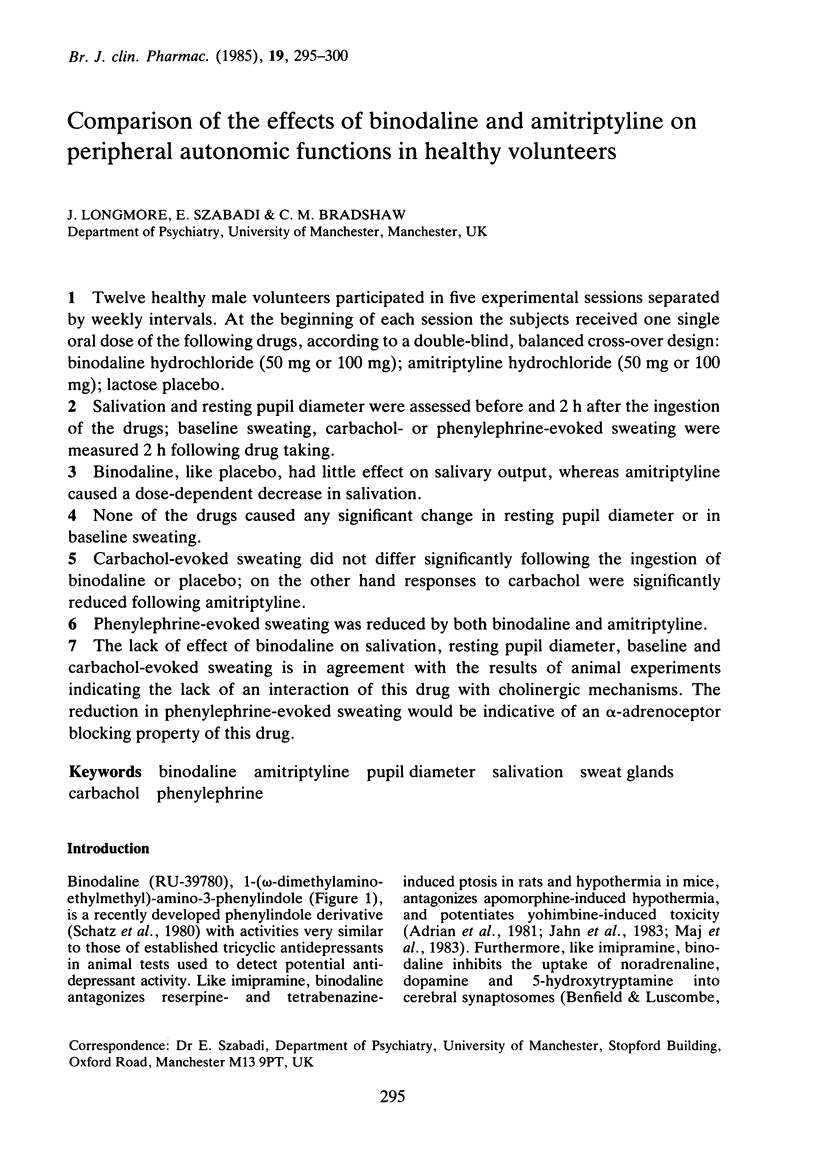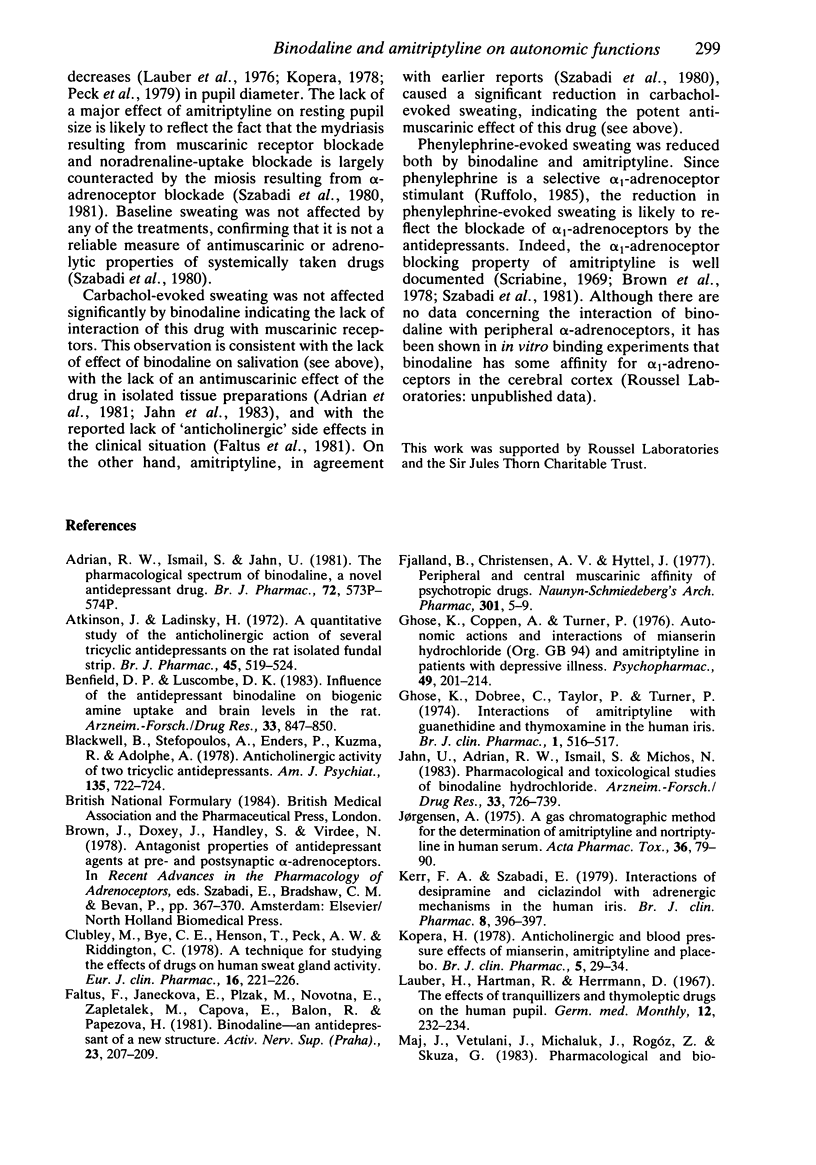Abstract
Twelve healthy male volunteers participated in five experimental sessions separated by weekly intervals. At the beginning of each session the subjects received one single oral dose of the following drugs, according to a double-blind, balanced cross-over design: binodaline hydrochloride (50 mg or 100 mg); amitriptyline hydrochloride (50 mg or 100 mg); lactose placebo. Salivation and resting pupil diameter were assessed before and 2 h after the ingestion of the drugs; baseline sweating, carbachol- or phenylephrine-evoked sweating were measured 2 h following drug taking. Binodaline, like placebo, had little effect on salivary output, whereas amitriptyline caused a dose-dependent decrease in salivation. None of the drugs caused any significant change in resting pupil diameter or in baseline sweating. Carbachol-evoked sweating did not differ significantly following the ingestion of binodaline or placebo; on the other hand responses to carbachol were significantly reduced following amitriptyline. Phenylephrine-evoked sweating was reduced by both binodaline and amitriptyline. The lack of effect of binodaline on salivation, resting pupil diameter, baseline and carbachol-evoked sweating is in agreement with the results of animal experiments indicating the lack of an interaction of this drug with cholinergic mechanisms. The reduction in phenylephrine-evoked sweating would be indicative of an alpha-adrenoceptor blocking property of this drug.
Full text
PDF





Selected References
These references are in PubMed. This may not be the complete list of references from this article.
- Atkinson J., Ladinsky H. A quantitative study of the anticholinergic action of several tricyclic antidepressants on the rat isolated fundal strip. Br J Pharmacol. 1972 Jul;45(3):519–524. doi: 10.1111/j.1476-5381.1972.tb08109.x. [DOI] [PMC free article] [PubMed] [Google Scholar]
- Benfield D. P., Luscombe D. K. Influence of the antidepressant binodaline on biogenic amine uptake and brain levels in the rat. Arzneimittelforschung. 1983;33(6):847–850. [PubMed] [Google Scholar]
- Blackwell B., Stefopoulos A., Enders P., Kuzma R., Adolphe A. Anticholinergic activity of two tricyclic antidepressants. Am J Psychiatry. 1978 Jun;135(6):722–724. doi: 10.1176/ajp.135.6.722. [DOI] [PubMed] [Google Scholar]
- Clubley M., Bye C. E., Henson T., Peck A. W., Riddington C. A technique for studying the effects of drugs on human sweat gland activity. Eur J Clin Pharmacol. 1978 Nov 27;14(3):221–226. doi: 10.1007/BF02089963. [DOI] [PubMed] [Google Scholar]
- Fjalland B., Christensen A. V., Hyttel J. Peripheral and central muscarinic receptor affinity of psychotropic drugs. Naunyn Schmiedebergs Arch Pharmacol. 1977 Dec;301(1):5–9. doi: 10.1007/BF00501257. [DOI] [PubMed] [Google Scholar]
- Ghose K., Coppen A., Turner P. Autonomic actions and interactions of mianserin hydrochloride (Org. GB 94) and amitriptyline in patients with depressive illness. Psychopharmacology (Berl) 1976 Sep 17;49(2):201–204. doi: 10.1007/BF00427291. [DOI] [PubMed] [Google Scholar]
- Jahn U., Adrian R. W., Ismail S., Michos N. Pharmacological and toxicological studies of binodaline hydrochloride. Arzneimittelforschung. 1983;33(5):726–739. [PubMed] [Google Scholar]
- Lauber H., Hartmann R., Hermann D. [The effects of tranquilizers and thymoleptic drugs on the human pupil]. Ger Med Mon. 1967 May;12(5):232–234. [PubMed] [Google Scholar]
- Maple S., Bradshaw C. M., Szabadi E. Pharmacological responsiveness of sweat glands in anxious patients and healthy volunteers. Br J Psychiatry. 1982 Aug;141:154–161. doi: 10.1192/bjp.141.2.154. [DOI] [PubMed] [Google Scholar]
- PECK R. E. The SHP test--an aid in the detection and measurement of depression. AMA Arch Gen Psychiatry. 1959 Jul;1:35–40. doi: 10.1001/archpsyc.1959.03590010051006. [DOI] [PubMed] [Google Scholar]
- Peck A. W., Bye C. E., Clubley M., Henson T., Riddington C. A comparison of bupropion hydrochloride with dexamphetamine and amitriptyline in healthy subjects. Br J Clin Pharmacol. 1979 May;7(5):469–478. doi: 10.1111/j.1365-2125.1979.tb00988.x. [DOI] [PMC free article] [PubMed] [Google Scholar]
- Schatz F., Jahn U., Wagner-Jauregg T., Zirngibl L., Thiele K. 1-amino-3-phenylindoles with antidepressant activity. Binodaline hydrochloride and related substances. Arzneimittelforschung. 1980;30(6):919–923. doi: 10.1002/chin.198038207. [DOI] [PubMed] [Google Scholar]
- Scriabine A. Some observations on the adrenergic blocking activity of desipramine and amitriptyline on aortic strips of rabbits. Experientia. 1969 Feb 15;25(2):164–165. doi: 10.1007/BF01899101. [DOI] [PubMed] [Google Scholar]
- Shur E., Checkley S. Pupil studies in depressed patients: an investigation of the mechanism of action of desipramine. Br J Psychiatry. 1982 Feb;140:181–184. doi: 10.1192/bjp.140.2.181. [DOI] [PubMed] [Google Scholar]
- Sneddon J. M., Turner P. The interactions of local guanethidine and sympathomimetic amines in the human eye. Arch Ophthalmol. 1969 May;81(5):622–627. doi: 10.1001/archopht.1969.00990010624005. [DOI] [PubMed] [Google Scholar]
- Snyder S. H., Yamamura H. I. Antidepressants and the muscarinic acetylcholine receptor. Arch Gen Psychiatry. 1977 Feb;34(2):236–239. doi: 10.1001/archpsyc.1977.01770140126014. [DOI] [PubMed] [Google Scholar]
- Szabadi E., Besson J., Bradshaw C. M. Pupil responsiveness to tyramine in depressed patients treated with amitriptyline. Br J Clin Pharmacol. 1975 Aug;2(4):362–363. doi: 10.1111/j.1365-2125.1975.tb02787.x. [DOI] [PMC free article] [PubMed] [Google Scholar]
- Szabadi E., Gaszner P., Bradshaw C. M. Interaction of desipramine and amitriptyline with adrenergic mechanisms in the human iris in vivo. Eur J Clin Pharmacol. 1981;19(6):403–408. doi: 10.1007/BF00548582. [DOI] [PubMed] [Google Scholar]
- Szabadi E., Gaszner P., Bradshaw C. M. The peripheral anticholinergic activity of tricyclic antidepressants: comparison of amitriptyline and desipramine in human volunteers. Br J Psychiatry. 1980 Nov;137:433–439. doi: 10.1192/bjp.137.5.433. [DOI] [PubMed] [Google Scholar]
- van den Broek M. D., Bradshaw C. M., Szabadi E. The effects of a psychological "stressor" and raised ambient temperature on the pharmacological responsiveness of human eccrine sweat glands: implications for sweat gland hyper-responsiveness in anxiety states. Eur J Clin Pharmacol. 1984;26(2):209–213. doi: 10.1007/BF00630287. [DOI] [PubMed] [Google Scholar]


